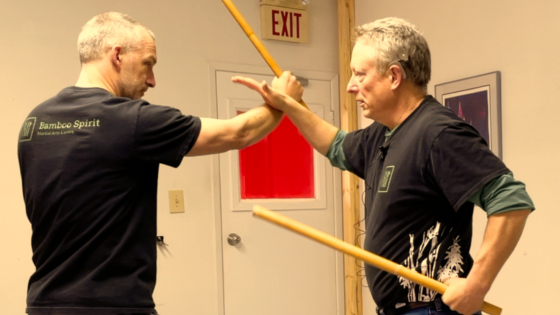Toronto Area Machete Attack
If you are not able to view this video, click here.
This machete attack occurred about a month ago in Brampton, a Toronto suburb. Joti Singh Mann, the victim, is a media personality, and the speculation in the local press is that he was attacked for views that he had expressed on his podcast.
I am most interested in the attack and what Mr. Mann could have done to protect himself. That said, I will not get into any cultural issue here and have no desire to wade into it. This post is more about the mechanics of the attack.
The attack begins with the axe-wielder attacking the driver’s side window with a right-handed grip. Then he switched to a double-handed grip to extricate the axe from the car window. Once the car door opens, he reverts to a right-handed grip. See below.

As Mr. Mann is pulled out of his vehicle, another attacker attacks him with a right-handed angle 12 attack. See below. For those unfamiliar with Filipino Martial Arts terms, angle 12 refers to an overhead attack.

As the clip below shows, The mass attack then migrates to the back of Mr. Mann’s vehicle. Every attacker is right-handed and hits the victim with repeated overhead attacks.

Unbelievably, Mr. Mann survived this horrific attack with serious injuries. The police are treating this attack as attempted murder. Mr. Mann had received death threats before this incident. It is not known what the death threats were for.
In any case, I have watched several machete attack videos on YouTube over the past few years, although not in an organized way. Based on my disorganized, haphazard viewings, I have the following observations:
- The vast majority of machete attacks are right-handed;
- The attacks are almost always overhead. Sometimes, it will be somewhere between angles 1 and 12.
- Most machete attacks involve a single attacker. The above video is somewhat unusual due to the nature of the attack.
- I don’t recall any machete attacks involving thrusts.
Why does this all matter?
We can stack the odds in our favour by knowing what a machete attack is, in probability, going to consist of. This will inform our self-defence options. Of course, the first thing we want to do is to escape or run away. However, if we have no choice but to defend ourselves, knowing the likely angle and direction of an attack is very useful.
I’ve been telling myself to watch machete videos on YouTube in an organized way and break them down into categories (single person, mass attack, right-handed or left-handed etc.) on a spreadsheet.
In light of this attack, it’s time for me to get cracking on this machete project. Stay tuned.
Back to the above machete attack. What could Mr. Mann have done to protect himself under these terrifying circumstances? Some have pointed out that he should not have opened his car door in response to the axe-wielder. I agree that Mr. Mann should have stayed in the vehicle and drove away.

On the other hand, it’s tough to judge someone who went through a terrifying experience. It’s nearly impossible to think clearly under these circumstances. It turns out he thought this was a carjacking, and he was getting out to let them take the vehicle. I’m thankful that he survived this incident. As of now, the attackers have not been apprehended.
Last Week’s Video
If you are not able to view the video, click here.
Last week’s video discussed “high palis palis,” a passing technique more appropriate for overhead or high-line attacks. This concept is incorporated into Flow Drill 15, a fun drill! Give it a try!
Once you get this down, you can mix it up with other concepts, as illustrated below.
Can this technique be used against a typical machete attack? Hell yes. One can theoretically pass a machete swing if you have an improvised weapon such as a broomstick or something similar. Emphasis on “theoretically.”
If you are not able to view this video, click here.
Anyway, play with the high palis palis, combine it with other Modern Arnis concepts, and see what you come up with.
Additional Reading
- Angles of Attack in Filipino Martial Arts
- Low High Palis Palis
- Amazing Palis Palis Drill!
- Which Technique Is Best?
- The Different Cobra Kai Dojos
Share this post:
- Click to share on Twitter (Opens in new window)
- Click to share on Facebook (Opens in new window)
- Click to share on LinkedIn (Opens in new window)
- Click to share on WhatsApp (Opens in new window)
- Click to share on Nextdoor (Opens in new window)
- Click to share on Pinterest (Opens in new window)
- Click to email a link to a friend (Opens in new window)
Brian Johns
Related Posts
3 Comments
Leave a Reply Cancel reply
Categories
- Arnis/Kali/Eskrima (113)
- Book Review (8)
- DVD Reviews (3)
- Guest Post (4)
- Inspiration (24)
- Martial Arts (99)
- My story (92)
- Safety (14)
- Tips & tricks (6)
- Uncategorized (3)
- YouTube Videos (8)






[…] are more concerned with the angle of attack rather than the method of attack. For example, an attack that targets the left temple of your head, whether it be empty hand, […]
[…] know, I will occasionally comment about violent incidents caught on video. I aim to glean lessons from the video and pass along my observations. Such is the case with a video of a violent mall […]
[…] uncanny resemblances to real-life events in Toronto. I anticipate that more episodes will resemble actual events in the Toronto […]